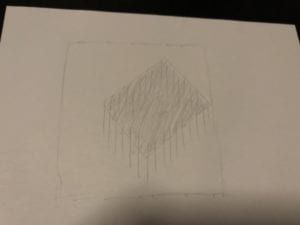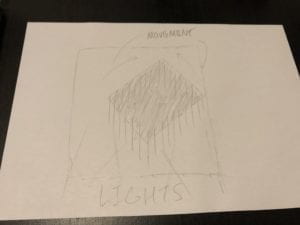Perspective and Context
Two artists who I think create excellent artwork and inspired my final project are Olafur Eliasson and Willem van Weegel. Eliasson’s usage of lights and shadows, combined with van Weegel’s style of using lines and boxes inspired my proposal that I will write further below.
For Olafur Eliasson, some of his work is a bit related to the concept of Mechanics and Optics, discussed from page 48 in Guy Brett’s book, The Century of Kinesthesia. In recent years, Eliasson has made countless works that make usage of motors and liquids to evoke the feeling of movement for the audience. Furthermore, he often uses circles or spheres in his works, much like Julio LeParc’s famous work, Continuous-Light-Cylinder. I believe that Eliasson makes excellent use of “the marriage of light, optics, and machine [to show] …avantgarde in its wildest form.” (47)
Eliasson’s work is also related to the concept of The Space of Abstraction. While Eliasson does tend to use circles and standard shapes in much of his works, he also uses the style of randomness with curved lines and shapes in some of his works which have a similar style to Georges Vantongerloo’s works. Eliasson incorporates the “free-form, random-seeming, and coloristically subtle and ambiguous approach to lines” (18). Vantongerloo’s Des elements is also somewhat similar to Eliasson’s Pistoletto compass and they both make use of curved lines and soft edges.
Willem van Weegel’s works are somewhat related to the Linear and Cyclical section of the reading. van Weegel’s kinetic pieces tend to move at a very slow pace, and at each step revealing new and different shapes that weren’t there before as the shapes rotate around and with each other. This way, his work “reveals to us a field of ‘actions’ in which the eye is no longer able to track the object’s journeys… only the quality of slowness allows [the object] to obliterate its own tracks” (35). This slowness is fully displayed in van Weegel’s work.
Furthermore, another way van Weegel’s works are related to Linear and Cyclical concepts are as follows. van Weegel’s works are not of the kinesthetic style in which movement and change move in a linear timeline, from point A to point B. van Weegel’s pieces instead move in a cyclical timeline, one which has no beginning or end, and continues endlessly.
For my project, I would like to use both of van Weegel’s and Eliasson’s styles into one piece that makes use of both, movement through physical movement, and the perception of movement through lights and shadows. van Weegel’s slow-moving works are a perfect inspiration for the way my work will move and change. Additionally, Eliasson’s usage of using motors, and combining the usage of light, optics, and machine is another inspiration for my project.
Another artist that inspired me is Robert Irwin, and one of the artists that inspired him, Kazimir Malevich. Malevich’s usage of abstractionism, minimalism, and basic shapes, combined with Irwin’s usage of near-blank canvases that leave the interpretation to the audience are what really gave me a clear image of what I would like my project to look like. I’d like to make a piece that complements what they have created before, and to make it my own through the addition of lights and movement.
Project Description
For the non-light related aspects of my project, I would like to make use of one of the classic abstractionist styles of using basic shapes. For me, I will use the square. As my ‘canvas’ I would like to have a basic background of a large white square (preferably fairly large), and within this canvas, a bit offset to either the right or left, I would have a second smaller square that is completely black in order to keep it from reflecting any color from the lights. This black square would have either thin strips of long black paper or black sticks that would always droop down (would have to be attached loosely). The black square would be attached to a motor (not sure which type yet) and rotate around different ways in different sequences.
For the light related aspect, I would like to use DMX lights and project them onto my ‘canvas’ As the DMX projects in different patterns and colors, there would not only be regular shadows appearing behind the box and lines (strips/sticks) but also some beautiful colored shadows. This can make it seem like there are more than just one set of box and lines, but multiple appearing as the DMX projects onto the canvas.
So in all, I want to make use of a large white square canvas, a slightly smaller square canvas which would be black, and black strips/sticks always going downwards that I would have along the outside edge of the black, inside canvas. DMX lights would then project towards these objects in different colors, patterns, and sequences. I would like the audience to experience not only the addition and subtraction of the ‘phantom objects’ through shadows and colored shadows, but the sense of movement through the rotating box and dangling lines.


Production Schedule
| 4/25 | research, find, and buy items necessary |
| 4/26 | start thinking of, and begin coding sequence for DMX lights |
| 4/27 | continue coding DMX |
| 4/28 | “ |
| 4/29 | items should start arriving, start piecing them together + coding |
| 4/30 | items should start arriving, start piecing them together + coding |
| 5/1 | items should start arriving, start piecing them together + coding |
| 5/2 | continue putting physical items together |
| 5/3 | buy any additional items necessary |
| 5/4 | continue coding sequence |
| 5/5 | think if there can be anything added + coding |
| 5/6 | finish up putting together the physical pieces |
| 5/7 | if any additional items arrive, place them onto the work |
| 5/8 | continue coding |
| 5/9 | ” + measuring distances between lights and physical pieces |
| 5/10 | start placing physical items into the display area |
| 5/11 | add any additional coding |
| 5/12 | clean up any bugs |
| 5/13 | complete placing physical items and DMX lights into the display area |
| 5/14 | listen to any critiques, tips, etc. from class and implement what can be implemented |